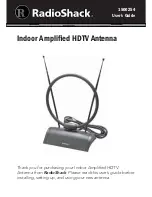
Maintenance
9711IMA-70
15-20
5.
If the wires and heat shrink are already
provided on the replacement switch,
disconnect the wires of the failed switch
and punch the wires of the replacement
switch into the IDC connector that plugs
into the Motor Termination PCB (refer to
drawing 134868 page 2 wiring diagram).
6.
Plug the IDC connector into the Motor
Termination PCB (refer to drawing
134868 page 2 wiring diagram).
15.5.
Balancing the Antenna
The antenna and equipment frame are balanced at the factory however, after disassembly for shipping or
maintenance, balance adjustment may be necessary. The elevation and cross-level motors have a brake
mechanism built into them, therefore,
power
must be ON to release the brakes and DishScan®
and antenna
drive
must be OFF to balance the antenna. .
Do NOT remove any of the drive belts
. Balancing is
accomplished by adding or removing balance trim weights at strategic locations to keep the antenna from falling
forward/backward or side to side. The antenna system is not pendulous so 'balanced' is defined as the antenna
remaining at rest when left in any position.
The “Balance Mode” selection located on the upper part of the “Four Quadrant Test” screen in the Tools –
Test menu page. When enabled, Balance Mode temporarily turns DishScan®, Azimuth, Elevation and Cross-Level
drive OFF. This function is required when trying to balance this antenna system.
Assure that Antenna power is ON and that the antenna has completed initialization.
At the Computer (connected to the MXP):
1.
Log into the GUI, select Tools - Test in the side bar menus.
2.
Select “Balance Mode” (located on the upper part of the “Four Quadrant Test” screen, just below the
page header) to enable balance mode. The screen will then show ON & OFF buttons.
3.
Click ON. The screen will temporarily display “Submitting … Please Wait”. When this message disappears
the antenna is in balance mode. DO NOT EXIT THIS SCREEN.
At the Antenna:
4.
At the Antenna: Balance the antenna with the elevation near horizon (referred to as front to back
balance) by adding, or subtracting, small counter-weights.
5.
Then balance Cross Level axis (referred to as left-right balance) by moving existing counter-weights
from the left to the right or from the right to the left. Always move weight from one location on
the equipment frame to the same location on the opposite side of the equipment frame (ie from the top
left of the reflector mounting frame to the top right of the reflector mounting frame). Do NOT add
counter-weight during this step.
6.
Last, balance the antenna with the elevation pointed at, or near, zenith (referred to as top to bottom
balance) by moving existing counter-weights from the top to the bottom or from the
bottom to the top. Always move weight from one location on the equipment frame to the same
location on the opposite side of the equipment frame (ie from the top left of the reflector mounting
frame to the bottom left of the reflector mounting frame). Do NOT add counter-weight during this step.
7.
When completed, the antenna will stay at any position it is pointed in for at least 5 minutes (with no ship
motion).
8.
Do NOT cycle antenna power to re-Initialize the antenna
. Return to the Computer (MXP), which
is still in Balance Mode. Click OFF. The screen will temporarily display “Submitting … Please Wait”. When
this message disappears the antenna is in normal operation mode. When you exit Balance Mode the
antenna will return to normal (DishScan®, Azimuth, Elevation and Cross-Level drive ON).
15.5.1.
Fine Balance and Monitoring Motor Drive Torque
The GRAPHS DISPTC graph chart provides a means for monitoring torque commands required for each
motor for diagnostic purposes and verifying antenna balance. By observing each trace, the required drive
of the antenna via the motor driver PCB may be established.
•
To view the Torque Commands, select the
graph chart.
EAR Controlled - ECCN EAR99
Summary of Contents for SEA TEL 9711IMA-70
Page 6: ...9711IMA 70 vi This Page Intentionally Left Blank EAR Controlled ECCN EAR99...
Page 10: ...9711IMA 70 Table of Contents x This Page Intentionally Left Blank EAR Controlled ECCN EAR99...
Page 14: ...Introduction 9711IMA 70 1 4 This Page Intentionally Left Blank EAR Controlled ECCN EAR99...
Page 60: ...Setup Azimuth Trim 9711IMA 70 7 2 This Page Intentionally Left Blank EAR Controlled ECCN EAR99...
Page 74: ...Setup Targeting 9711IMA 70 10 4 This Page Intentionally Left Blank EAR Controlled ECCN EAR99...
Page 124: ...Drawings 9711IMA 70 18 2 This Page Intentionally Left Blank EAR Controlled ECCN EAR99...
Page 132: ...EAR Controlled ECCN EAR99...
Page 133: ...EAR Controlled ECCN EAR99...
Page 134: ...EAR Controlled ECCN EAR99...
Page 159: ...EAR Controlled ECCN EAR99...
Page 160: ...EAR Controlled ECCN EAR99...
Page 165: ...EAR Controlled ECCN EAR99...
Page 177: ...EAR Controlled ECCN EAR99...
Page 178: ...EAR Controlled ECCN EAR99...
















































